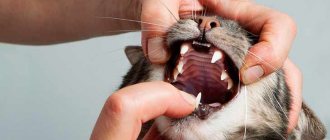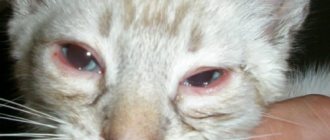The term hyphema describes the presence of blood in the anterior chamber of the eye - what to do if you find blood in your cat's eye. Bleeding usually comes from the iris blood vessels, but can also come from the ciliary body (tissue behind the iris), from the choroidal vasculature (the layer of tissue under the retina), or from the blood vessels of the retina.
Many cats suffering from hyphema experience decreased visual function or eye damage. However, if only one eye is involved, the cat's behavior is usually normal. Eyes affected by hyphema may be painful, appear half-closed, and be characterized by increased tearing and persistent blinking of the eyelids. Hyphema caused by trauma is often accompanied by bleeding or bruising of the conjunctiva and tissues surrounding the eye.
Blood in a cat's eye
Bleeding, if extensive or recurrent, may completely fill the anterior chamber, resulting in complete hyphae and blindness. Eyes with severe hyphema are at greater risk of developing glaucoma (high intraocular pressure) and should be closely monitored for this potential complication.
Initially, the blood inside the eye appears bright red. Blood may remain uncoagulated and settle at the bottom of the eye. The blood may also clot and become dark brown or bluish-gray in color over time.
The presence of a hyphema may be a symptom of severe ocular pathology or a manifestation of an internal problem located in other areas of the body. Although hyphema is often caused by trauma to the eye, spontaneous hyphema can occur in the presence of many different ocular and systemic diseases. Therefore, immediate identification of the cause is of paramount importance.
Regarding visual function, the prognosis depends on the degree of the disease (mild or severe), as the pupil may become dilated during treatment and there may be bleeding or damage to the back of the eye. The presence of severe hyphema, lack of pupil dilation, hemorrhages in the back of the eye, or retinal detachment often leads to blindness.
Pyometra
Among the most common diseases of cats with bloody discharge is pyometra, a form of purulent endometritis in which pus accumulates in the uterine cavity. The disease is most often provoked by rash actions of the owners themselves, namely:
- abuse of hormonal drugs during estrus;
- uncontrolled mating;
- infection in the vagina during childbirth.
There are two types of pyometra:
- Open form - blood clots come out of the vagina. The cat licks itself frequently, approximately every 15-20 minutes. The animal's temperature rises, the cat often drinks water.
- Closed form - no discharge visible, because blood accumulates in the uterine cavity. Symptoms of the closed form of pyometra: enlarged, tight abdomen, frequent urination, apathy, rapid breathing.
Of these two forms, the second poses the greatest threat to health, because. excessive accumulation of pus in the uterus can lead to the death of the animal.
Causes
In general, reasons can fall into different categories:
- Hyphema caused by closed or penetrating trauma.
- Chronic or severe uveitis. This is an inflammation of the iris, ciliary body and choroid.
- Coagulation disorders are caused by changes in platelet number or functionality and other clotting factors.
- Systemic hypertension, that is, increased blood pressure.
- Systemic diseases affecting coagulation or ocular blood vessels, such as some viral infections (feline infectious peritonitis), some leukemias, and acute increases in serum proteins.
- Retinal detachment or lacerations of retinal vessels.
- Neoplasia of the eye or other areas of the body.
- Specific causes that may be associated with the development of hyphema include:
- Closed trauma or trauma passing through closed eyelids, such as road traffic accidents, gunshots to the head.
- Penetrating injuries or injuries that pierce the eye.
- Ocular prosthesis, or protrusion of the eyeball out of the orbit, usually as a result of closed head trauma.
- Uveitis with hemorrhage that occurs from the blood vessels of the iris, from the ciliary body and from the choroidal tissues.
- Systemic hypertension (high blood pressure) is associated with diseases such as chronic kidney disease and hyperthyroidism (an overactive thyroid gland).
- Accidental ingestion of toxins from rodenticides such as warfarin or brodifacoum, or ingestion of dead rodents with such toxins.
- Chronic liver disease with decreased production of clotting factors and vitamin K.
- Coumadin toxicity is caused by an overdose of this drug (prescribed to treat certain cardiovascular diseases).
- Low platelet count (thrombocytopenia) or decreased platelet function.
- Hyperviscosity syndrome, which develops when the level of protein macromolecules in the bloodstream is extremely high.
- Primary neoplasms of the iris and ciliary body or other neoplasms that arise in the eye.
- Metastatic tumors that have spread to the eyes from other areas of the body.
- Systemic hypertension (high blood pressure), leading to hemorrhage in the choroid, retina and vitreous body and retinal detachment.
- Retinal detachment with hemorrhage originating from the choroid or torn blood vessels of the retina due to ocular trauma, systemic hypertension, uveitis, postoperative uveitis (for example, after cataract surgery) and chronic glaucoma, resulting in an enlarged globe with crystalline shift.
Symptoms
Redness in the eye located between the cornea and the pupil. Collecting blood may hide part of the iris or pupil. It may settle to the floor of the anterior chamber due to gravity or form a blood clot in the chamber.
Other signs of injury (bruises, wounds), inflammation or irritation (redness, discharge from the eyes) of the eye.
Pain may occur, accompanied by the presence of half-closed or closed eyes.
Decreased vision or monocular blindness (if only one eye is affected) or binocular blindness (if the condition affects both eyes).
After mating
Bloody discharge from the loop may appear in a cat after mating in the event of resorption of the fetus, which can occur at any stage of pregnancy. In most cases, the animal’s body independently copes with the problem , expelling the dead fetuses from the womb, but they can also remain in the uterus for quite a long time.
As a result, fruit rot begins, which can lead to inflammation of the cat’s genitals and blood poisoning. Resorption of the fruit is accompanied by bleeding with pus and mucus. Blood clots have a rather pungent odor.
A possible cause of bleeding after mating can also be an ectopic pregnancy. In this case, urgent assistance from a veterinarian is necessary—delayed surgical intervention can lead to the death of the pet.
Diagnostics
Complete medical history and in-depth physical examination.
It is recommended that you inform your veterinarian of any potential exposure to toxins or poisons, head or eye injuries, patterns of (sudden or gradual) bleeding, medications currently being administered to your cat, pre-existing medical conditions, or recent physical abnormalities observed in the cat.
Complete ophthalmological examination.
Typically, this includes: examining the inside of the eye using appropriate magnifying glasses, fluorescein staining of the cornea, and tonometry to determine the presence of glaucoma. It is important to determine the extent of the hyphema, check whether it affects only the anterior chamber or even the back of the eye, and whether it affects one or both eyes. The veterinarian, if deemed necessary, may refer the owner to a veterinary ophthalmologist for further evaluation of the hyphema using appropriate instruments.
Laboratory research
A complete blood count, which includes a platelet count (to look for any infection or inflammation and to ensure there are enough platelets).
Serum biochemical panel to evaluate organ function and to measure the level of proteins present in the serum.
Thyroid function test. May be prescribed for older cats with hyperthyroidism.
Specialized blood tests. They are necessary to assess blood clotting.
Taking blood pressure to determine if your cat has high blood pressure.
General urine test for suspected renal pathology.
X-rays of the chest and abdominal cavity. They may be recommended if blood test results show other organic abnormalities.
Your veterinarian or veterinary ophthalmologist may recommend additional diagnostic tests to look for other body conditions or to assess the extent of eye damage, including:
Ocular ultrasound
This is an imaging technique that shows the structures present at the back of the eye and behind the eye. This test is especially useful when the hyphema is so severe that it prevents examination of the back of the eye with conventional instruments. Ultrasonography can help detect the presence of abnormal masses in the eye, lens luxation, retinal detachment, or vitreous hemorrhages.
Radiographs of the skull and orbit.
They may be necessary to identify the presence of fractures in cats that have suffered head trauma. Plain radiographs (white) are also useful in identifying any metallic foreign bodies.
Ultrasound of the abdominal cavity.
This may be recommended if laboratory tests reveal abnormalities in certain abdominal organs or the potential presence of a tumor in the abdominal cavity.
Bone marrow aspirate (collection of cells from the bone marrow). This may be performed to evaluate the bone marrow's ability to produce platelets or to detect bone marrow cancer.
Treatment
The goals of therapy are to treat eye inflammation due to bleeding and any underlying causes of bleeding. Treatment of hyphema itself provides the following:
Topical corticosteroids, in the form of eye drops or ointment. They are used to reduce inflammation present in the anterior chamber of the eye.
Topical atropine, in the form of eye drops or ointment. It is used to dilate the pupil. The expansion of the latter helps relieve pain and minimize adhesion between the iris and the crystal.
Treatment of glaucoma, if the latter has caused hyphema or developed as a result of edema, is prescribed if intraocular pressure is high.
Discharge after pregnancy
The presence of bloody discharge in a pregnant cat is completely normal when it is presented as transparent, homogeneous, odorless clots.
However, prolonged discharge of purulent-bloody discharge with a greenish tint after birth indicates possible inflammation of the animal’s genital organs.
It often happens that the fetus gets stuck in the cat's womb, or the placenta for some reason does not come out of the uterus, as a result of which the process of rotting begins. In both cases, surgical removal of the foreign object will be required, because prolonged decomposition inside the animal's body can lead to intoxication of the pet.
Sometimes bloody discharge during the postpartum period may be just remnants of the placenta. Usually the placenta is completely expelled from the uterus within 3 hours after birth, and the number of membranes should correspond to the number of kittens. In this case, surgical intervention is not required.
What to do at home
Keep your cat at home as quiet as possible to stop bleeding, allow the hyphema to settle in the eye, and reduce the risk of further bleeding. It may be necessary to limit your cat's physical activity for 7-10 days.
Since in some cases vision deteriorates, it is recommended not to allow the cat to go outside without supervision until complete recovery.
Do not give your cat over-the-counter human medications such as Visine or other ophthalmic medications designed to reduce eye redness or irritation, as these products are not effective for hyphema.
Contact your veterinarian as soon as possible, because some causes of hyphema are dangerous not only for the eyesight, but also for the life of the animal.











